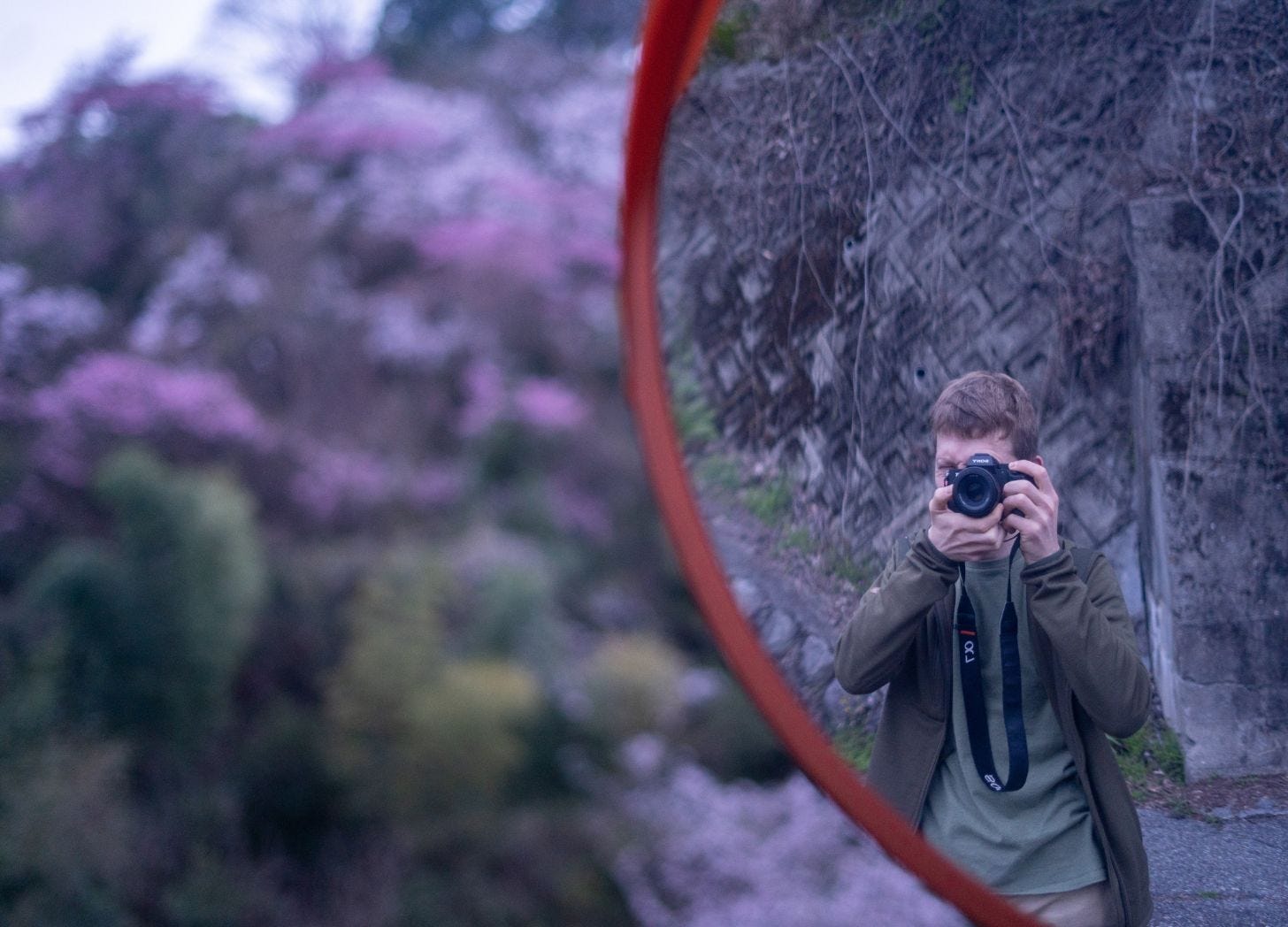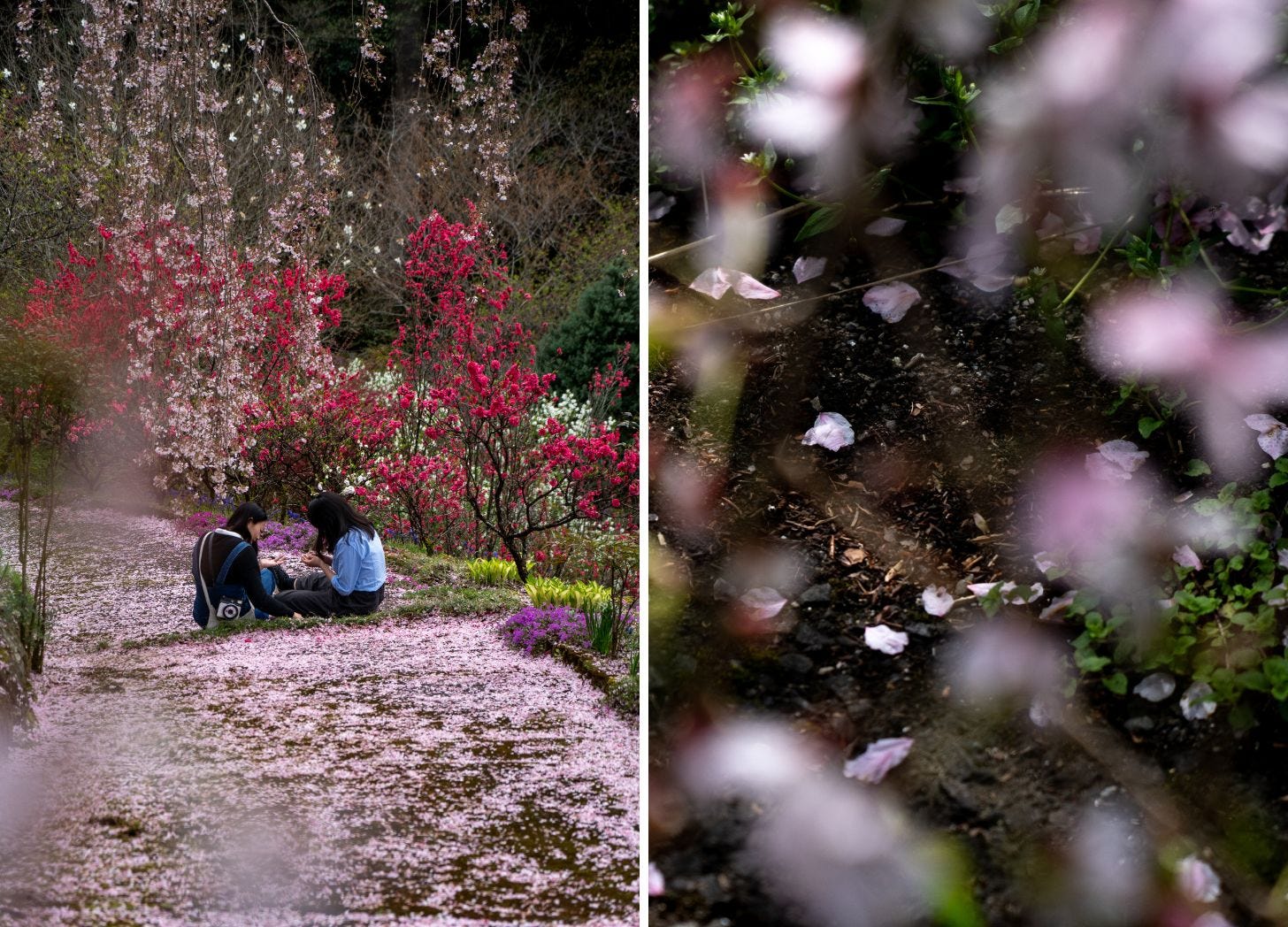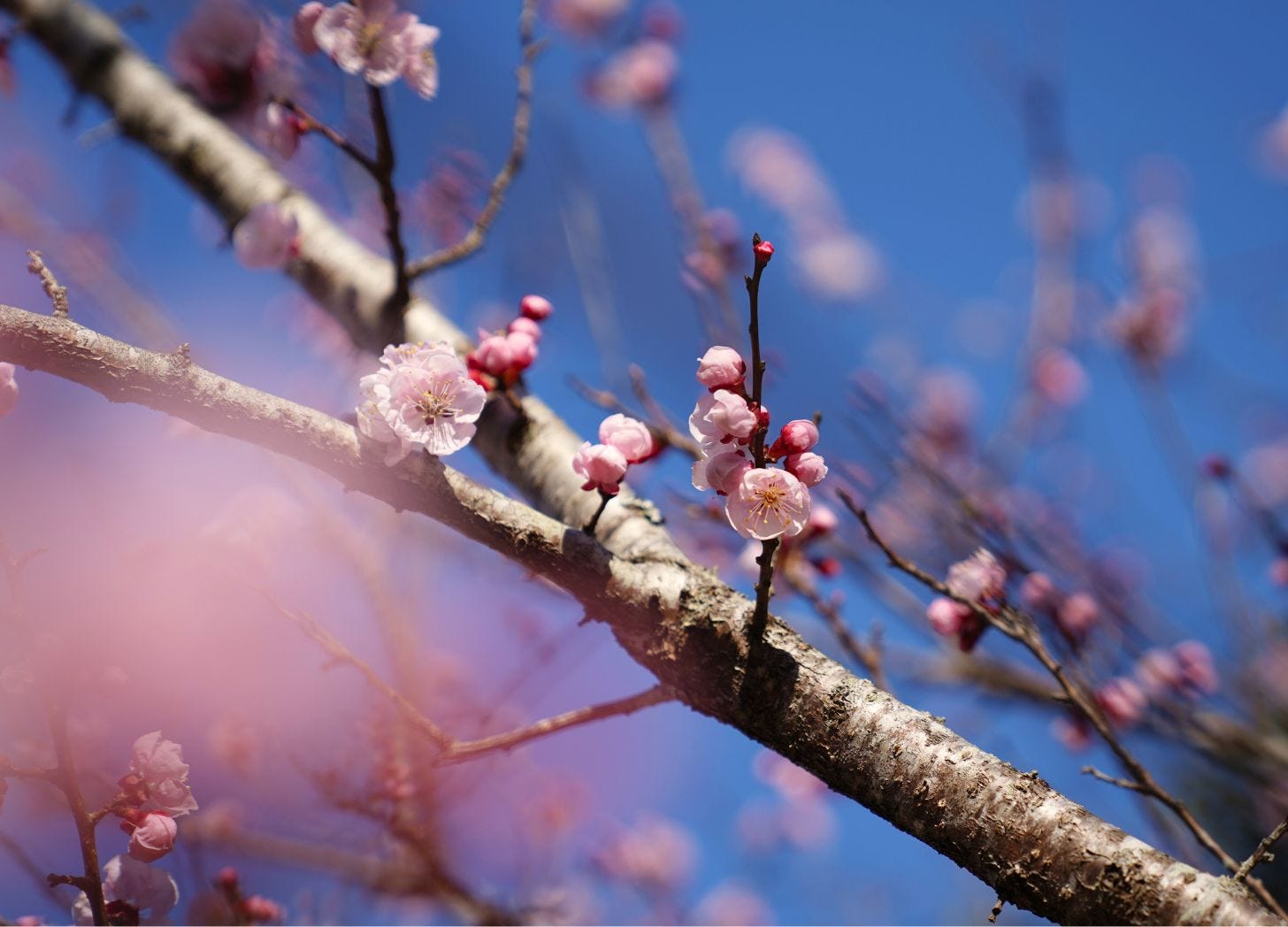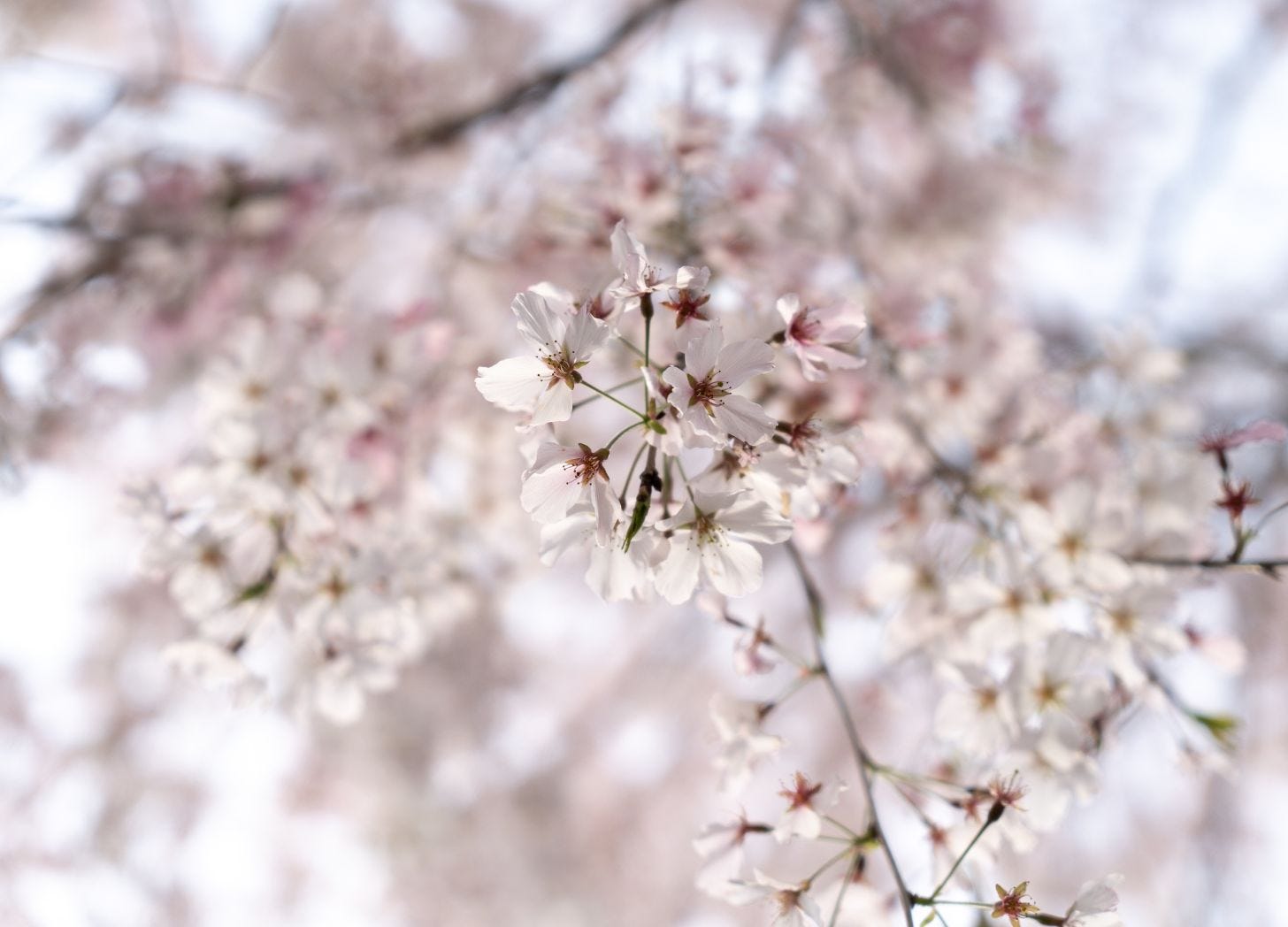Travelling to Japan in spring can be a chaotic time, especially in cities like Kyoto, which already struggle with overtourism. The sheer volume of visitors eager to see spring blooms pushes the city and its residents to the very limits. Friends who have visited Kyoto recently lamented that it’s hard to walk around and that the only way to “avoid tourists” is to go out before 6:00 a.m. The irony, of course, is that they, too, are tourists, trying to escape others in the same situation.
In contrast, being among the pink blossoms in a rural place is an entirely different experience. The trees feel more ordinary (more lonely, even). Just there. No crowds, no cameras, no rush. It makes my heart ache to think of its beauty going unnoticed, but how lovely I can enjoy them in peace.
One afternoon, I watched an elderly woman slowly approach a sakura tree, pausing with each step to look up. There’s a tenderness in moments like that—a quiet intimacy with nature. The other day, my partner was moved to tears by the way sunlight filtered through the flowers. How often do we get to witness a whole tree in bloom, every branch full of pale blossoms? It feels like magic. It is magic.
I’ve always known that the beloved trio of ume (plum), momo (peach), and sakura (cherry) all blossom around the same time, but I never knew how to tell them apart. Once you learn the differences, looking becomes more interesting.
When I see people photographing a blossoming tree, I wonder—are they really looking? Do they notice the shape of the petals, and how they extend from the branch? Do the petals open gently, falling softly from the centre? Or do they jut outward, as if about to be pressed between panes of glass?
Ume, Momo, Sakura
All three belong to the Rosaceae (rose) family—a vast family of over 3,000 species.
Ume is the earliest bloomer and signals the arrival of early spring. Its image often appears on New Year’s cards, symbolizing renewal. The flowering period is between late January to late March.
Momo blossoms are closely associated with the Girl’s Festival on March 3, a holiday celebrating and praying for the growth of girls. A couple weeks ago, we visited a local shrine to see the decorations for Girl’s Day.
And then, of course, there’s sakura—the most iconic symbol of spring in Japan (and Japan itself). Sakura’s flowering period is between mid-March to late April, but the flowers only last about a week. FLEETING. Compared to ume and momo, sakura blooms in an instant and disappears just as quickly. Each year, smart weather people try to predict the exact moment of full bloom, but it seems like a futile pursuit. The flowers arrive when they’re ready and when that is, I think only the flowers know.
April marks the start of the new school year, and for many businesses, a new fiscal year. With the full bloom, there’s a collective feeling of renewal. How fitting that a “new year” comes with spring. I’ve long felt spring, as a season, is a much more appropriately timed new year.
The most anticipated tradition of spring is hanami or flower viewing—think canopy of cherry blossoms, picnics, and laughter. In the countryside, it can be serene, but in cities like Tokyo, it’s often far more crowded (more people, more drinks, louder music). A little less idyllic, but a celebration nonetheless.
What to Look For
Not all pale pink flowers are sakura. All three, ume, momo, and sakura, come in varying shades of white, pink, and red.
Ume petals are round and soft, growing close to the branch with barely any stalk.
Momo has slightly pointed petals and a short, wispy stem. Two flowers often bloom from one node. They often look like little pom-poms!
Sakura have petals with a tiny split at the tip, forming a heart-like shape. To me, sakura looks the most delicate and fragile. I’ve never really spent time observing the nodes (the point at which the flower connects with the stem). For sakura, several flowers bloom from one node, and the stems attaching the node to the flowers are longer.
Close Your Eyes and Smell
After COVID, many people became more aware of this often under-appreciated sense (especially those who lost it). I’ve been fascinated by how different cultures relate to scent. In English, we tend to describe smells by comparison: “It smells like lemon” or “like roses.” But some languages don’t rely on analogies and have a much more abstract relationship with smell.
The Jahai people of the Malay Peninsula1, for example, can name smells as easily as we name colours. A study I came across found that while English speakers tried to locate the source of a scent, Jahai speakers used abstract terms to relate to scents. Our relationship to smell, it turns out, is deeply cultural.
Back to blossoms: their scent offers a quieter, more intimate way to experience them. Ume has the strongest fragrance—soft and sweet, a little like jasmine.
「東風吹かば匂ひおこせよ梅の花
あるじなしとて春な忘れそ」
When the east wind blows, the plum blossoms give off their fragrance
Momo is gentler, but the scent sometimes comes from the branch itself. It reminds me of something sweet and floral, also small hints of jasmine.
Sakura, on the other hand, barely has a scent at all. Some wild varieties do, but they’re rare, especially in cities.
Spring moves gently and swiftly. One week the mountains and the tree branches are bare, the next they’re full of blossoms, and just as suddenly as they come, the petals scatter like dust in the wind. It’s the joy that also aches because this moment is temporary and in that, it’s beauty.
There’s something tender about slowing down and guiding your eyes and nose to notice a shape, a scent, a quiet detail. The world around you begins to blur, and like a camera coming into focus, we can capture a small fleeting moment.
What’s blooming near you? How is the arrival of birds and other signs of life? 🌸
Here’s an accompanying Spotify instrumental piano soundtrack for your spring musings. It started with a piano song called “f l o w e r” by Yirma and then the rest of the songs (many flower and spring-themed) found their way into the playlist.
Have a beautiful week ahead,
Kana















Amazing pictures, worth the 6:00am, tell him thanks!
I have just returned from a visit to Japan, where I lived 30 years ago. It was so beautiful to return, especially during sakura season. I hadn't known before that sakura were planted all over Japan after WWII. Such a poetic way to rebuild a country. Thank you, Kana-chan, for bringing rural Japan to my inbox!